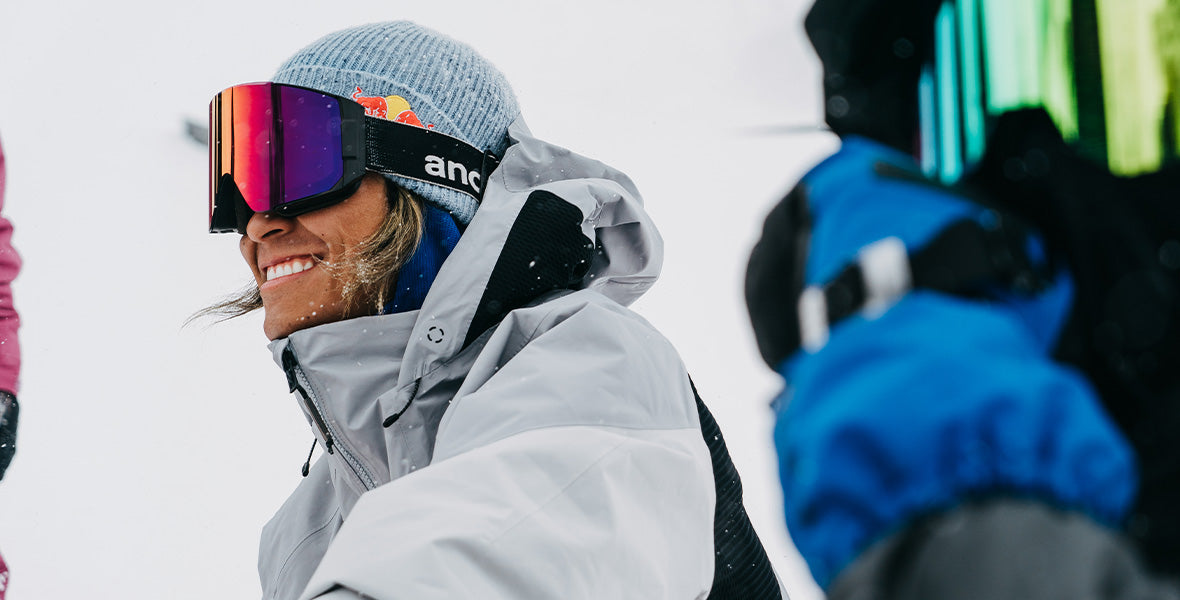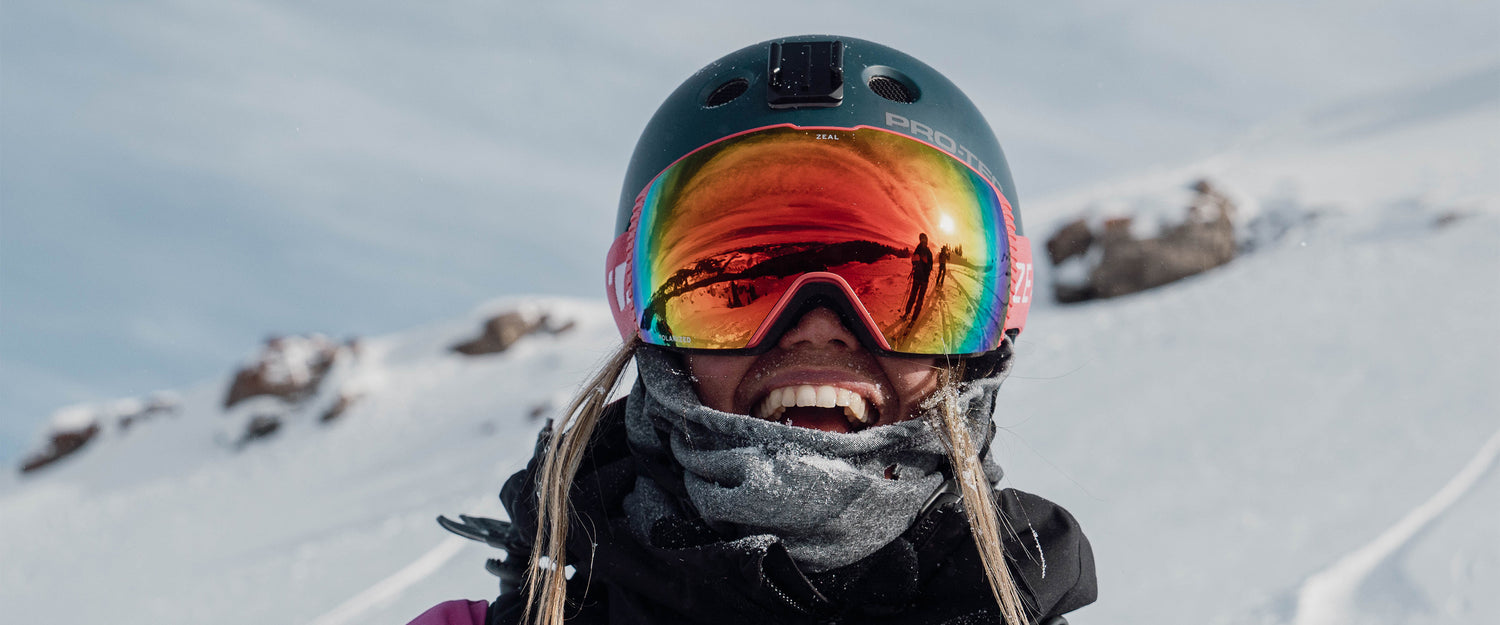The sun is shining, blazing, practically blinding. You lower your ski goggles over your eyes and see... absolutely nothing! The question is, Do you have the right lens for the day’s conditions?
Ski goggles aren’t just about style. They protect your eyes and give you clear, sharp, accurate vision both to avoid dangerous obstacles and find stupendous powder lines. Understanding the role of each ski goggle feature is a big plus when making your purchase.

Understanding Lens Tints: VLT Rating
The quantity of light, as a percentage, transmitted through goggles is translated into a VLT (Visible Light Transmission) rating that allows you to define in which light conditions the lenses perform the best.
The higher the VLT, the more light passes through the lens. This type of lighter-tinted lens is ideal for night conditions. The lower the VLT, the less light can get in, which is perfect for sunny days. These lenses have darker tints.
To shed more light on the subject, here’s a guide to lens tints for Anon ski goggles. However, each brand has its own guide based on its lens models. So you should refer to them according to your choice of ski goggles.

6% to 29% VLT
This first category performs well on sunny days. It allows less light to enter the goggles, which gives you maximum protection when the sun is bright.
30% to 55% VLT
This second category is the most versatile one. It allows 30% to 55% of light to enter the goggles, which gives you a clear, accurate view in both sunny and variable weather.
55% to 85% VLT
The last category performs its best when the light is low; namely, in the evening or during a snowstorm—in what is often called flat light. This type of lens lets in more light and gives you clear vision, even when night skiing.
Photochromic Lenses
Photochromic lenses have the advantage of adapting to conditions by changing the tint according to brightness. Available from many ski goggle brands, including Oakley and Smith, photochromic lenses darken or lighten depending on the conditions, so you can own just one lens. The change may take a few minutes as the lens adjusts to the brightness.

Choosing the Lens Shape: Spherical or Cylindrical
Spherical Lenses
Thanks to their round shape, spherical lenses broaden your field of vision. They’re also curved horizontally and vertically. This characteristic helps reduce distortion, resulting in clear, accurate vision.
Cylindrical Lenses
Cylindrical lenses don’t give you the same peripheral vision as their counterparts, but they perform just as well. The horizontally curved but vertically flat shape reduces the distortion effect. However, they are less expensive than spherical ones.
Toric Lenses
At first glance, toric lenses can look like a cylindrical lens. However, don’t be fooled: its construction is almost identical to that of spherical lenses. The difference is that they are curved more horizontally than vertically, which optimizes peripheral vision. In addition, toric lenses provide superior performance thanks to the much wider field of vision.

Moisture- and Oil-Resistant Coating
This coating repels water, oil and dirt so that the lens is easy to clean or wipe off. The oil repellent coating is the same as the one on cellphone screens.
Choosing Your Ski Goggle Size
There are various sizes of ski goggles that fit different face and ski helmet shapes. If you need new ski goggles, try them on while wearing your helmet. Why? Because you want the two pieces of equipment to fit together as one with no space between them. The helmet shouldn’t push them down on your nose.
Ski goggle models come in different sizes—small, medium or large. There are also specific frames for women’s morphology, for children and low-bridge fit goggles (aka Asian fit).
Try the ski goggles on your face, and make sure the shape and foam are comfortable.
Over the Glasses (OTG)
Wearing eyeglasses under ski goggles can be complicated. Over the Glasses (OTG) technology is designed to make the shape of ski goggles fit over your eyeglasses’ frame.

How to Stop Ski Goggles from Fogging Up?
A sworn enemy of skiing, the notorious fog that forms in your goggles does so for a reason. A few simple tips can help you avoid it. First, many lenses are treated with an anti-fog coating during manufacture. This is done to the inside of the lens; that is, the part facing your eyes. Never clean it, even if you’re really tempted. Doing so removes the coating, which then no longer prevents fogging.
Second, avoid wearing your goggles on your helmet or hat and then putting them back on over your eyes. It’s best to keep them on your face during chairlift rides and descents.
Third, wearing ski goggles over a neck warmer traps moisture and creates fog. Finally, make sure that the goggle model fits your face; there should be no space at the forehead or pressure on your nose.

How to Change Ski Goggle Lenses?
Many models of ski goggles are sold with a bonus lens. The advantage is that you’ll have two lens tints on hand that will allow you to adapt to weather conditions. There are a number of lens technologies that make swapping lenses quicker and easier.
Changing Traditional Lenses
Many models of ski goggles don’t necessarily have magnetic or other technologies for swapping out lenses. To make a change, simply remove the lens from the frame by pushing on the frame to open it slightly.
Interlocking System
To make a change, simply remove the lens from the frame by pushing on the frame to open it slightly.
Magnet system
Some brands have a magnetic lens change system. This makes it very easy to remove and replace the lens.
Rail System
For this system, the frame of the ski goggles features a rail on each side, and the lens has small hooks. This makes it very simple to push the lens upwards to remove it and then reinsert it onto the rails to put it back in place.
Lock system
Smith offers the Mag Lock system, which features a magnetic strip along the top of the frame and two locking mechanisms in the corners. Simply open the locking mechanisms, remove the lens, then put it back on, aligning it with the magnetic strip and closing the levers on the locking mechanisms.
To fully understand the various systems for different brands, watch our video!




